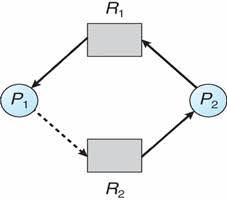Deadlock Avoidance:
Deadlock prevention algorithms prevent deadlocks by
restraining how requests can be made. Possible side effects of preventing
deadlocks by this method however are low
device utilization and reduced system throughput.
An alternative method for avoiding deadlocks is to require additional information about
how resources are to be requested. For example in a system with one
tape drive and one printer, we might be told that process ‘P’ will request first the tape drive, and later the printer,
before releasing both resources. Process
‘Q’, on the other hand, will request
first the printer and then the tape drive.
With this knowledge of the complete sequence of request and
release for each process we can decide for each request whether or not the
process should wait.
Each request requires that the system consider the resources
currently available, the resources currently allocated to each process, and the
future request and releases of each process, to decide whether the current
request can be satisfied or must wait to avoid a possible future deadlock.
The simplest and most useful model requires that each process
declared the maximum number of resources of each type that it may need.
Given a priori information about the maximum number of
resources of each type that may be requested for each process, it is possible
to construct an algorithm that ensures that the system will never enter a
deadlock state.
This algorithm defines the deadlock avoidance approach. A deadlock avoidance algorithm dynamically examines the resource allocation
state to ensure that the circular wait condition can never exist.
The resource
allocation state is defined by the
number of available and allocated resources, and the maximum demands of the
processes.
1.
Safe State: A state is safe if the system can allocate resources to each process up to its
maximum in some order and still avoid a deadlock. More formally, a system is in a safe state only if there exists a safe
sequence.
A sequence of processes <P1,P2,...,Pn>
is a sequence for the current allocation state if, for each Pi the resources that Pi can still
request can be satisfied by the currently available resources plus the
resources held by all the Pj with j<i. If no such sequence exists then the system state is said to be unsafe.
(Safe, unsafe and deadlock state spaces)
A safe state is not a deadlock state. Conversely, a deadlock
state is an unsafe state.
Not all unsafe states are deadlocks; however an unsafe state
may lead to a deadlock.
As long as the state is safe, the operating system can avoid
unsafe and deadlock states.
In an unsafe state, the operating system cannot prevent the
processes from requesting resources such that a deadlock occurs.
Given the concept of unsafe state, we can define avoidance
algorithms that ensure that the system will never deadlock. The idea is simply to ensure that the system
will always remain in a safe state.
Initially, the system is in a safe state. Whenever a process
request a resource that is currently available, the system must decide whether
the resource can be allocated immediately or whether the process must wait. The
request is granted only if the
allocation leaves the system in a safe state.
In this scheme, if a process request resource that is
currently available, it may still have to wait. Thus, resource utilization may be lower than it would be without a
deadlock avoidance algorithm.
2.
Resource Allocation Graph Algorithm:
If we have a resource allocation system with only one
instance of each resource type, a variant of the resource allocation graph can
be used for deadlock avoidance.
In addition to the request and assignment edges, we introduce a new type of edge called
claim edge.
A claim edge Pi ->Rj indicates that
process Pi may request resource Rj at some time in the
future. This edge resembles request edge in direction, but it is separated by a
dashed line.
When process Pi request resource Rj,
the claim edge Pi ->Rj is converted to request edge.
Similarly, when a resource Rj is released by Pi,
the assignment edge Rj->Pi is already converted to a
claim edge Pi ->Rj.
Note that the resources
must be claimed a priori in the system i.e. before process Pi
starts executing, all its claim edges
must already appeared in the resource allocation graph.
An algorithm for detecting a cycle in the graph acquires an
order of n2 operations,
where ‘n’ is the number of processes
in the system.
(Resource allocation graph for deadlock avoidance)
If no cycle exists
then the allocation of the resource
will leave the system in a safe state.
If cycle is found,
then the allocation will put the
system in an unsafe state.


No comments:
Post a Comment